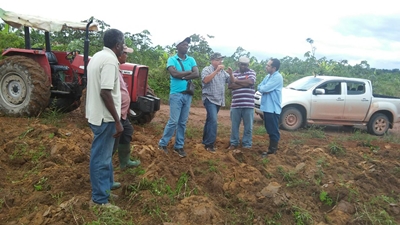Project encourages innovative intensive rice production in Suriname
Project encourages innovative intensive rice production in Suriname
In April, the Brazilian Cooperation Agency (ABC/MRE) and Embrapa started a technical cooperation project with the Ministry of Agriculture of Suriname to conduct research activities to develop upland rice crops, which are cultivated by the Maroon community.
In Suriname, a South American country that has borders with Brazil in the state of Roraima, upland rice is cultivated by the Maroon people with traditional practices, with a yield nearing 1,000 kg/hectare. In the country, the area used by farmers for upland rice cultivation varies between 1 and 10 m². In addition, it is not exclusive, as other crops such as cassava or cowpeas are cultivated in the same areas. Thus, by using cultivation techniques such as fertilization, adequate spacing and plant population, and weed control, the expectation is to double rice productivity in the country.
The research, which is financially backed by the New Zealand government, comprises a trilateral cooperation project between Brazil, Suriname, and New Zealand entitled "Support to the Improvement of Upland Rice Cultivation in Suriname". The work is under implementation at the Victoria experimental station in the Bokopondo district, 150 km away from the capital, Paramaribo.
Onsite studies compared the performance of three traditional upland rice varieties in Suriname (Topi-Topi, Watra Lantie, and Koelie Alesi) with four Brazilian ones (BRS Sertaneja, BRS Pepita, BRS Curinga, and BRS Esmeralda). In addition, the fields were divided into parcels to assess best concentrations of soil fertilization regarding the nutrients nitrogen, phosphorus, and potassium. The project stipulates that Surinamese and Brazilian specialists are going to define best management alternatives for upland rice crops by 2017.
The Victoria experimental station is located in the countryside, close to villages that cultivate rice in artisanal means. The intention is to provide local farmers with the opportunitiy to be in contact with the proposed cultivation techniques so that they can adapt them to suit their needs. Therefore, the project also has a participatory research nature.
The first project activities included a visit from April 22 to May 01 by researcher Adriano Nascente and agricultural technicial Antônio Teixeira, who joined the technician from the Surinamese Ministry of Agriculture, Ms. Ruby Kromokardi, to set up the experiments at Victoria. The harvest is due for August, the time when statistical analysed will be carried out to define the best results for rice cultivation in Suriname. In November, new fields will be implemented to demonstrate such results to the local population.
According to Ruby, the implementation of the project will help the population that cultivates the grain have the means to increase productivity and produce enough food for the whole year instead of buying rice from other regions.
Author: Adriano Stephan Nascente, Researcher at Embrapa Rice and Beans
Translation: Mariana de Lima Medeiros
Rodrigo Peixoto (1.077 MTb/GO)
Embrapa Rice and Beans
Press inquiries
arroz-e-feijao.imprensa@embrapa.br
Phone number: (62) 3533-2137
Further information on the topic
Citizen Attention Service (SAC)
www.embrapa.br/contact-us/sac/

